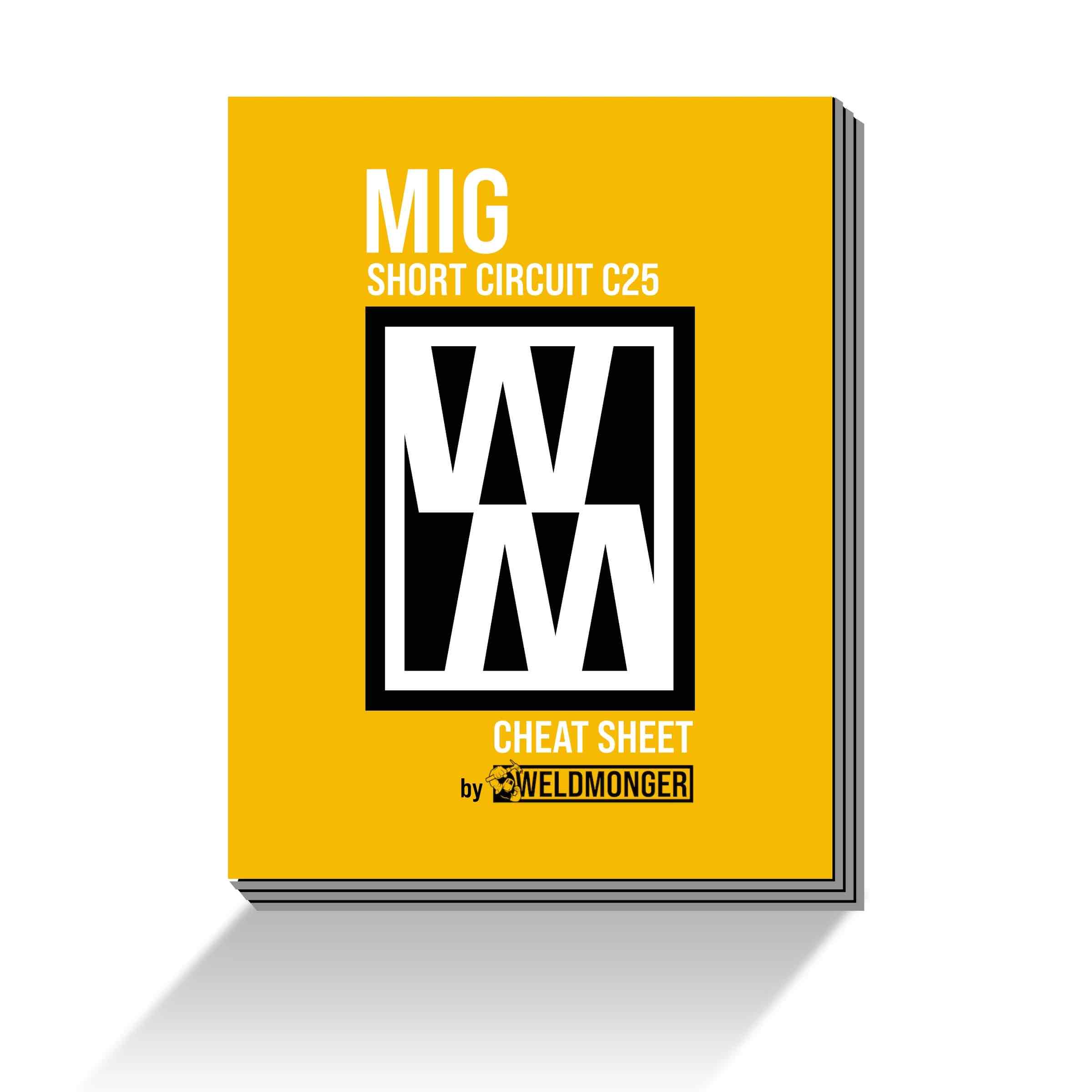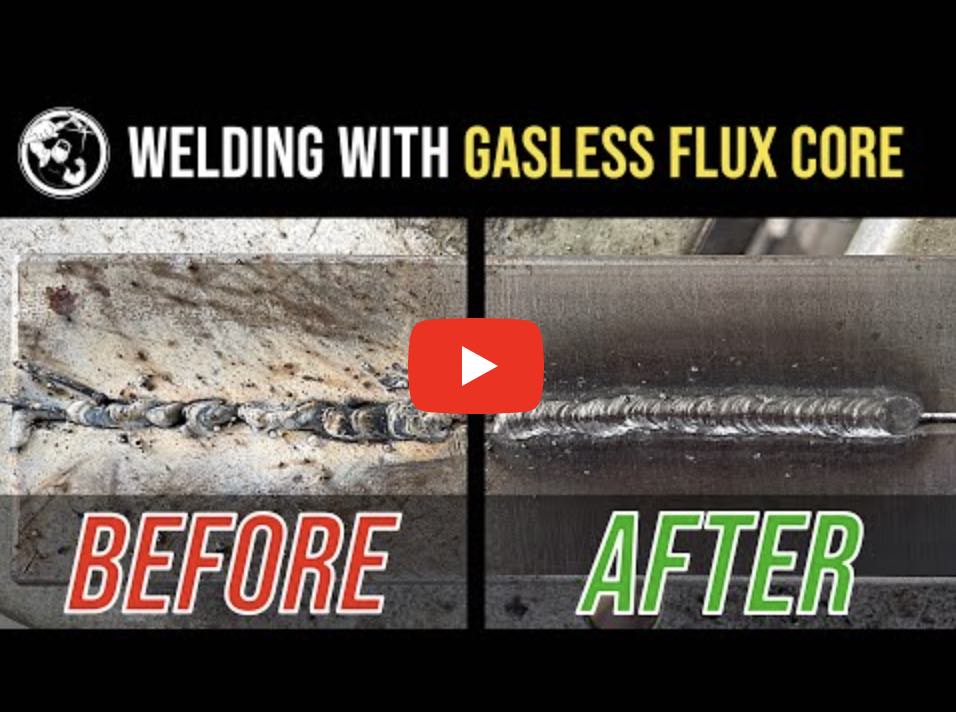GMAW
GAS METAL ARC WELDING aka MIG Welding
Download the FREE Weldmonger MIG mini course workbook here
- HOME
- MIG WELDING
- Gmaw
About Gas Metal Arc Welding (GMAW)
First off, "Gas Metal Arc Welding" is a lot of words to say.
Even the abbreviated term GMAW doesn't exactly roll off the tongue.
So you are going to hear it called MIG more than by the proper term GMAW in normal everyday conversation.
MIG stands for Metal wire Inert Gas because argon and helium were used at first.
But after advancements in gas mixes included active gases like Co2, the name was changed to "Gas Metal Arc Welding"
Typically you will see the acronym GMAW on technical documents like procedures and codes but people still call it MIG welding.
Safety Precautions and Personal Protective Equipment (PPE) for GMAW
Just like with all arc welding processes, the basic safety precautions involve protecting your eyes, ears, skin, and lungs.
So safety glasses, face shields, welding helmets etc are for eye protection , earplugs and or earmuffs for ears, appropriate clothing, jackets and gloves for the skin, and respirator and or fume extractor or other method for the lungs.
The comprehensive safety precautions for GMAW can be found in AWS Z49.1 that you can find as a free download at AWS.org
The link below sometimes changes but if you just go to AWS.org and look for free resources, you will find it.
Make sure to read and understand it before doing any welding.
Overview of GMAW
There are several different types of welding that can be done using the same MIG welding machine.
short circuit mig welding aka "short arc" is used for auto body panels and even for medium duty fabrication up to around 1/4" thickness.
Short circuit mig is capable of welding in all positions and uses bare wire in diameters ranging from .023" to .045".
.030" and .035" diameters are the most common size wires.
As a rule of thumb, smaller wire works better on thin metal and larger wire works better on thicker metal...but there is a lot of overlap in what size wire works best for what.
.023" is great for auto body work, .030" is great to have if you occasionally weld really thin metal, and .035" might be the best choice for 1/8" thick and thicer.
75/25 argon/co2 gas is the most common gas for short circuit mig but pure Co2 can also be used.
Spray transfer also uses bare wire and is a much hotter process than short circuit mig.
Spray transfer does not lend itself to uphill welding but is great for flat horizontal, downhill, and even some overhead fillet weld applications.
Spray transfer requires a higher percentage of argon than short circuit mig welding. A fairly common gas for spray is 90/10 argon/Co2 and one reason for that is that 90/10 gas also works well with pulsed spray.
There are many other mixes available like 95/5, 98/2 etc. and all have specific applications.
Flux core welding can also be done using the same mig welding machine.
There are 2 main types of flux core welding.
self shielded flux core
gas shielded flux core aka dual shield
Flux core welding is a separate topic and you can see many videos and pages about flux core here.
Advantages and Disadvantages of GMAW
The main advantage to GMAW is speed and productivity.
Because GMAW is a wire fed process, there is very little interuption in productivity.
There is no need to stop and restart like there is with stick welding (smaw shielded metal arc welding).
Another advantage is that GMAW is fairly easy to learn.
The main disadvantages are that it is not as portable as stick welding because it requires shielding gas...And it is not as clean or precise as TIG welding.
Another big disadvantage is that the welder has the ability to tune the settings much lower than what are required to make a sound weld.
When you couple using cold settings with hot rolled mill scale, lack of fusion is usually the result
See video below
GMAW Equipment and Components
Power Source - this is the welding machine and usually its the constant voltage design
Wire Feeder - Sometimes the wire feeder is a separate unit.
Welding Gun - also called a mig gun
Shielding Gas - 75/25 argon/co2 for short circuit mig, pure argon for mig welding aluminum, 90/10 argon/co2 or higher argon mixtures for spray and pulse spray
Types of GMAW metal transfer
- Short Circuit Transfer
- Spray Transfer
- Pulse spray GMAW
- Globular
How GMAW works
Gas Metal Arc Welding (GMAW), commonly known as MIG (Metal Inert Gas) welding, is a versatile and widely used welding process that joins metals together.
Here's an overview of how it works:
1. **Setup:**
- The process starts with setting up the welding equipment. This includes a welding machine, a gas cylinder, a spool of welding wire, and a welding gun.
- The welding wire for GMAW is usually made of a solid core or a metal core, and it serves as the electrode as well as the filler metal .
2. **Powering Up:**
- Once all connections are made for the shielding gas and the ground clamp is securely clamped to the work, and of course the appropriate PPE like welding helmet, gloves, and jacket are on. The machine can be turned on for welding.
3. **Creating an Arc:**
When the welder pulls the trigger on the mig gun, 3 things happen all at once….The wire becomes electrically hot, the wire feeder starts feeding wire, and the shielding gas comes on. Things happen quickly so the welder needs to be in position to weld before pulling the trigger.
- The electric arc forms between the end of the welding wire and the metal being welded.
- The intense heat from the arc causes the welding wire to melt and form a pool of molten metal.
4. **Shielding Gas:**
- Simultaneously, a shielding gas is released through the welding gun. This gas shields the molten metal from the surrounding air, preventing oxidation and ensuring a clean, strong weld.
- Common shielding gases include argon, carbon dioxide, or a mixture of gases, depending on the specific welding requirements.
For carbon steels a mixture of argon and c02 is common, but for aluminum, pure argon is used.
5. **Transfer of Metal:**
- The molten metal from the welding wire is transferred to the workpiece, melting the base metal and creating a weld puddle. It is up to the person doing the welding to make sure settings are correct and technique is sound so that adequate fusion and penetration happen.
There are 3 main types of metal transfer (some sources say 4 and include pulsed spray)
- short circuit - most common for light fabrication and most versatile for welding all positions as well as really thin metal like auto body.
- globular - less common than either short circuit or spray. Sometimes globular metal transfer happens from poor voltage and wire settings.
- spray - for manufacturing and production work on thicker metals…very hot and very fast but not for welding really thin metals or vertical uphill.
pulse spray is a variation of spray transfer - a spray process controlled by pulsed current that permits welding vertical uphill.
In Gas Metal Arc Welding (GMAW), also known as MIG welding, there are several modes of metal transfer that describe how the molten metal from the electrode is transferred to the weld pool. These modes are determined by factors such as welding current, voltage, and shielding gas. The main modes of metal transfer in GMAW are:
1. Short-Circuit Transfer (Short-Arc Transfer)
Description:
- In this mode, the welding wire makes contact with the workpiece, causing a short circuit. The wire melts, creating a small droplet that is transferred to the weld pool.
- The wire then retracts, breaking the short circuit, and the process repeats.
Characteristics:
- Low heat input
- Suitable for thin materials and out-of-position welding
- Produces less spatter
- Can be used with CO2 or a CO2/argon gas mixture
**2. Globular Transfer
Description:
- The welding wire melts and forms larger droplets that are transferred to the weld pool due to gravity.
- This mode occurs at higher currents and voltages than short-circuit transfer.
Characteristics:
- Higher heat input compared to short-circuit transfer
- Produces more spatter
- Less controlled and less stable than other modes
- Generally not preferred for critical welds or thin materials
3. Spray Transfer
Description:
- The welding wire melts and forms a fine spray of tiny droplets that are transferred across the arc to the weld pool.
- This mode occurs at high currents and voltages.
Characteristics:
- High heat input
- Suitable for thicker materials and high-speed welding
- Produces a stable arc and minimal spatter
- Requires argon-rich shielding gas (usually at least 80% argon)
4. Pulsed Spray Transfer
Description:
- This mode alternates between a high current (peak current) and a low current (background current).
- During the peak current phase, the wire melts and a droplet is transferred, while the background current maintains the arc without transferring metal.
Characteristics:
- Lower heat input than continuous spray transfer
- Suitable for thin materials and out-of-position welding
- Produces less spatter and provides good control over the weld pool
- Requires specialized pulsing equipment and argon-rich shielding gas
Each mode of metal transfer in GMAW offers distinct advantages and is suitable for different applications and material thicknesses. Choosing the appropriate mode depends on factors like the type of material being welded, the desired weld quality, and the welding position.
Understanding the modes of transfer in GMAW aka MIG welding helps when deciding what welding machine to buy for your application.
As an example, while a small mig welder like the primeweld mig180 is great for auto body work and light duty fabrication, it is pretty much only capable of short circuit transfer because of amperage and duty cycle limitations.















